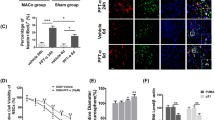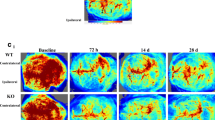Abstract
The endothelial transient receptor potential cation channel subfamily V member 4 (TRPV4) plays a crucial role in vascular remodeling; however, TRPV4-mediated angiogenesis after ischemic neuronal death as a neurorestorative strategy has not yet been thoroughly examined. In this study, we first tested whether TRPV4 activation can improve functional recovery in rats subjected to transient brain ischemia. The possible mechanisms for TRPV4 activation-promoted functional recovery were explored. A TRPV4 agonist, 4α-phorbol 12,13-didecanoate (4α-PDD), was intravenously injected via the tail vein at 6 h and 1, 2, 3, 4 days after ischemic stroke. The treatment reduced infarct volume by almost 50% (14.7 ± 3.7 vs. 29.2 ± 6.2%; p < 0.0001) and improved functional outcomes (p = 0.03) on day 5. To explore the therapeutic mechanism, we measured endothelial nitric oxide synthase (eNOS) expression and phosphorylation, vascular endothelial growth factor A (VEGFA) signaling, and neural stem/progenitor cells (NPCs). TRPV4 activation significantly increased eNOS expression and phosphorylation (serine 1177) by more than 2-fold in the ischemic region. The expressions of VEGFA and VEGF receptor-2 were significantly higher in the treated animals, especially an increase of the proangiogenic VEGFA164a isoform while a decrease of the antiangiogenic VEGFA165b isoform. We evaluated angiogenesis by detecting microvessel density in ischemic region. Using the immunohistochemistry staining, we found that 4α-PDD treatment caused a 3.4-fold increase of microvessel density (p < 0.0001). In addition, NPC proliferation and migration in the ischemic hemisphere were increased by 3-fold and 5-fold, respectively. In conclusion, our data suggest that TRPV4 activation by 4α-PDD may improve poststroke functional improvement through angiogenesis and neurogenesis.






Similar content being viewed by others
Abbreviations
- 4α-PDD:
-
4α-Phorbol 12,13-didecanoate
- BBB:
-
Blood–brain barrier
- EPCs:
-
Endothelial progenitor cells
- ECs:
-
Endothelial cells
- FSS:
-
Fluid shear stress
- GS:
-
Garcia score
- eNOS:
-
Endothelial nitric oxide synthase
- NPCs:
-
Neural stem/progenitor cells
- NO:
-
Nitric oxide
- SVZ:
-
Subventricular zone
- tMCAO:
-
Transient middle carotid artery occlusion
- TRPV4:
-
Transient receptor potential vanilloid 4
- VEGFA:
-
Vascular endothelial growth factor A
- VEGFR2:
-
VEGF receptor-2
References
Mozaffarian D, Benjamin EJ, Go AS et al (2016) Heart disease and stroke statistics-2016 update: a report from the American Heart Association. Circulation 133:e38–e360
Meyer S, Verheyden G, Brinkmann N et al (2015) Functional and motor outcome 5 years after stroke is equivalent to outcome at 2 months: Follow-up of the collaborative evaluation of rehabilitation in stroke across Europe. Stroke 46:1613–1619
Cowman S, Royston M, Hickey A et al (2010) Stroke and nursing home care: a national survey of nursing homes. BMC Geriatr 10:4
Teng H, Zhang ZG, Wang L et al (2008) Coupling of angiogenesis and neurogenesis in cultured endothelial cells and neural progenitor cells after stroke. J Cereb Blood Flow Metab 28:764–771
Zhang ZG, Chopp M (2009) Neurorestorative therapies for stroke: underlying mechanisms and translation to the clinic. Lancet Neurol 8:491–500
Kahle MP, Bix GJ (2013) Neuronal restoration following ischemic stroke: influences, barriers, and therapeutic potential. Neurorehabil Neural Repair 27:469–478
Everaerts W, Nilius B, Owsianik G (2010) The vanilloid transient receptor potential channel TRPV4: from structure to disease. Prog Biophys Mol Biol 103:2–17
Troidl C, Troidl K, Schierling W et al (2009) Trpv4 induces collateral vessel growth during regeneration of the arterial circulation. J Cell Mol Med 13:2613–2621
Zaninetti R, Fornarelli A, Ciarletta M et al (2011) Activation of TRPV4 channels reduces migration of immortalized neuroendocrine cells. J Neurochem 116:606–615
Hatano N, Suzuki H, Itoh Y et al (2013) TRPV4 partially participates in proliferation of human brain capillary endothelial cells. Life Sci 92:317–324
Randhawa PK, Jaggi AS (2015) TRPV1 and TRPV4 channels: potential therapeutic targets for ischemic conditioning-induced cardioprotection. Eur J Pharmacol 746:180–185
Dragoni S, Guerra G, Fiorio Pla A et al (2015) A functional transient receptor potential vanilloid 4 (TRPV4) channel is expressed in human endothelial progenitor cells. J Cell Physiol 230:95–104
Schmidt W, Endres M, Dimeo F et al (2013) Train the vessel, gain the brain: physical activity and vessel function and the impact on stroke prevention and outcome in cerebrovascular disease. Cerebrovasc Dis 35:303–312
Liu J, Wang Y, Akamatsu Y et al (2014) Vascular remodeling after ischemic stroke: mechanisms and therapeutic potentials. Prog Neurobiol 115:138–156
Schierling W, Troidl K, Apfelbeck H et al (2011) Cerebral arteriogenesis is enhanced by pharmacological as well as fluid-shear-stress activation of the Trpv4 calcium channel. Eur J Vasc Endovasc Surg 41:589–596
Wragg JW, Durant S, McGettrick HM et al (2014) Shear stress regulated gene expression and angiogenesis in vascular endothelium. Microcirculation 21:290–300
Zhang L, Hu X, Luo J et al (2013) Physical exercise improves functional recovery through mitigation of autophagy, attenuation of apoptosis and enhancement of neurogenesis after MCAO in rats. BMC Neurosci 14:1
Ke Z, Yip S, Li L et al (2011) The effects of voluntary, involuntary, and forced exercises on brain-derived neurotrophic factor and motor function recovery: a rat brain ischemia model. PLoS One 6:e16643
Zhu J, Song W, Li L et al (2016) Endothelial nitric oxide synthase: a potential therapeutic target for cerebrovascular diseases. Mol Brain 9:30
Gertz K, Endres M (2008) eNOS and stroke: prevention, treatment and recovery. Future Neurol 3:537–550
Gao Y, Zhao Y, Pan J et al (2014) Treadmill exercise promotes angiogenesis in the ischemic penumbra of rat brains through caveolin-1/VEGF signaling pathways. Brain Res 1585:83–90
Mac Gabhann F, Qutub AA, Annex BH et al (2010) Systems biology of pro-angiogenic therapies targeting the VEGF system. Wiley Interdiscip Rev Syst Biol Med 2:694–707
Rajagopalan S, Mohler ER, Lederman RJ et al (2003) Regional angiogenesis with vascular endothelial growth factor in peripheral arterial disease: a phase II randomized, double-blind, controlled study of adenoviral delivery of vascular endothelial growth factor 121 in patients with disabling intermittent claudication. Circulation 108:1933–1938
Kikuchi R, Nakamura K, MacLauchlan S et al (2014) An antiangiogenic isoform of VEGF-A contributes to impaired vascularization in peripheral artery disease. Nat Med 20:1464–1471
Harper SJ, Bates DO (2008) VEGF-A splicing: the key to anti-angiogenic therapeutics? Nat Rev Cancer 8:880–887
Sawada M, Sawamoto K (2013) Mechanisms of neurogenesis in the normal and injured adult brain. Keio J Med 62:13–28
Saha B, Peron S, Murray K et al (2013) Cortical lesion stimulates adult subventricular zone neural progenitor cell proliferation and migration to the site of injury. Stem Cell Res 11:965–977
Christie KJ, Turnley AM (2013) Regulation of endogenous neural stem/progenitor cells for neural repair-factors that promote neurogenesis and gliogenesis in the normal and damaged brain. Front Cell Neurosci 6:70
Carreira BP, Morte MI, Inácio  et al (2010) Nitric oxide stimulates the proliferation of neural stem cells bypassing the epidermal growth factor receptor. Stem Cells 28:1219–1230
Zhang RL, Zhang Z, Zhang L et al (2006) Delayed treatment with sildenafil enhances neurogenesis and improves functional recovery in aged rats after focal cerebral ischemia. J Neurosci Res 83:1213–1219
Chen J, Zacharek A, Zhang C et al (2005) Endothelial nitric oxide synthase regulates brain derived neurotrophic factor expression and neurogenesis after stroke in mice. J Neurosci 25:2366–2375
Jie P, Lu Z, Hong Z et al (2016) Activation of transient receptor potential vanilloid 4 is involved in neuronal injury in middle cerebral artery occlusion in mice. Mol Neurobiol 53:8–17
Li L, Qu W, Zhou L et al (2013) Activation of transient receptor potential vanilloid 4 increases NMDA-activated current in hippocampal pyramidal neurons. Front Cell Neurosci 7:17
Navaratna D, Guo S, Arai K et al (2009) Mechanisms and targets for angiogenic therapy after stroke. Cell Adhes Migr 3:216–223
Acknowledgements
We thank JY. Wang (Division of Colorectal Surgery, Department of Surgery, Kaohsiung Medical University) for technical support. This work was supported by the following funding: Ministry of Science and Technology (Taiwan, R.O.C.; MOST 103-2314-B-075-076-MY3, MOST 104-2745-B-037-001, MOST 105-2314-B-039-050, MOST 103-2314-B-037-027-MY2) and National Health Research Institutes (Taiwan, R.O.C.; NHRI-EX106-10605PI).
Author information
Authors and Affiliations
Corresponding author
Ethics declarations
All experimental procedures were approved by the Institutional Animal Ethical Committee Kaohsiung Medical University and were conducted according to the Guide for the Care and Use of Laboratory Animal of the National Institute of Health.
Conflict of Interest
The authors declare that they have no conflict of interest.
Electronic Supplementary Material
Supplementary Fig. 1
Schematic illustration of the experimental design. Transient middle cerebral artery occlusion (tMCAO) was inducted by 2-h occlusion in right internal carotid artery. 4a-phorbol-12,13-didecanoate (4α-PDD) was used as an agonist for endothelial transient receptor potential vanilloid 4.* represents the test points for neurological deficits score (NDS). ** represents the test points for infarct volume. # represents the test points for Garcia score (GS). (GIF 15 kb)
Supplementary Fig. 2
Delayed deaths are not observed with 4α-PDD treatment. Mortality was assessed during 5 d after tMCAO in 4α-PDD group (n = 23), and control group (treated with DMSO, n = 26). Mortality at day 5 was not significantly different. (GIF 34 kb)
Supplementary Table S1
(DOCX 13 kb)
Supplementary Table S2
(DOCX 14 kb)
Rights and permissions
About this article
Cite this article
Chen, CK., Hsu, PY., Wang, TM. et al. TRPV4 Activation Contributes Functional Recovery from Ischemic Stroke via Angiogenesis and Neurogenesis. Mol Neurobiol 55, 4127–4135 (2018). https://doi.org/10.1007/s12035-017-0625-0
Received:
Accepted:
Published:
Issue Date:
DOI: https://doi.org/10.1007/s12035-017-0625-0




